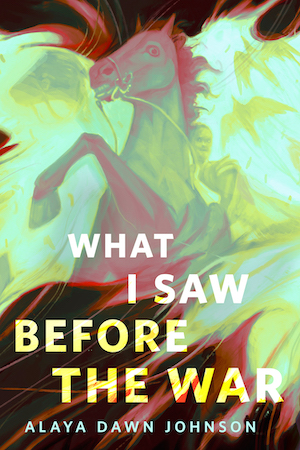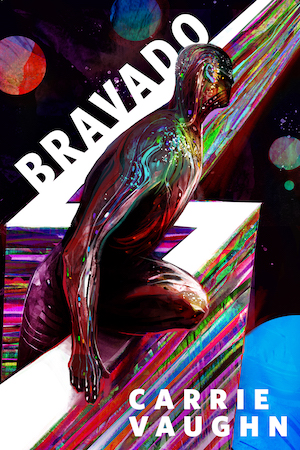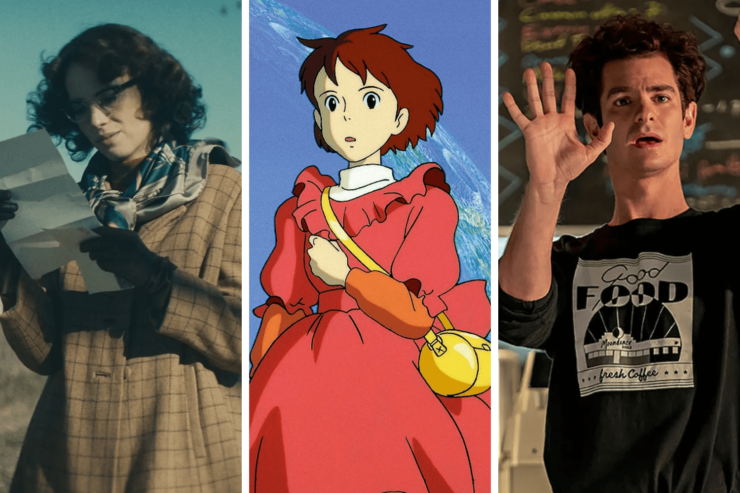It’s extremely difficult to talk about the creative process. I absolutely love reading about craft—both because I’m looking for tips, and because the more time I spend reading about other writers’ habits the less time I have to spend actually writing.
Paris Review interviews? Hell yeah! Photo essays about writers’ desks? Sign me up! Movies about artists working?
Umm… about that.
So many film and TV series about artists’ lives include montages of terrible behavior briefly interrupted by moments of epiphany, furiously typed voiceover, maniacal splatters of paint. Even Amadeus, one of my favorite movies of all time, shows Wulfie writing music that seems to be playing for him in some celestial sphere that only he has access to. Even Wonder Boys, one of the greatest “writer movies” ever put to celluloid, resorts to “the author narrates the thing he’s writing as he types it, hit save, and closes the document looking pleased with his work” in the very last moments.
And I understand! it’s extremely hard to capture the alchemy of the creative process on screen. But here I wanted to look at a few examples that take a different approach, and try to not only immerse the audience in the artist’s work, but also to acknowledge that it is, in fact, hard work.
It isn’t just taking dictation, no matter what that glorious (extremely fictionalized) Salieri says.
“Sunday”, Tick, Tick… Boom!
I am not actually a musical theater nerd. I was never a Renthead, I went into Les Miz thinking it was about the French Revolution (sorry), I came to Jonathan Groff through Mindhunter, I went to Cats in the theater to bask in a trainwreck.
However, one of my favorite movies of recent years is a piece of musical theater about musical theater. I don’t even know how many times I’ve watched Tick, Tick… Boom! at this point, because something about its focus on process, and its brutal honesty about failure, has been comforting to me.
One of its best moments, and the one that best illustrates what I’m trying to get at here, is the “Sunday” sequence. “Sunday” is a parody of a more iconic “Sunday”—the first act closing number in Stephen Sondheim’s Sunday in the Park with George. But rather than just seeing Jonathan Larson singing it to himself while he worked at the Moondance Diner, or riffing while he and his friends watch Sunday in the Park on PBS together, Lin-Manuel Miranda re-imagines it as a full musical number during the Sunday brunch shift. The customers are all played by Broadway legends, but at the beginning of the scene they’re also just annoyed customers, New Yorkers lining up for cinnamon coffee and mimosas before an afternoon at the Met or the Chelsea Flea Market. As Larson starts his song, they all join in, transforming into the stars they are, as Larson populates the diner with his musical theater heroes and transforms his exhausting, demoralizing diner gig into a musical number that becomes a living portrait of modern life, just like Sondheim’s reimagining of Seurat’s A Sunday on La Grande Jatte—1884.
American Fiction
I found a lot to love in American Fiction, though I don’t think I was as bowled over by it as some people—possibly a result of being in publishing too long, and seeing that most of the jokes are still just… how things are. But there was one scene that really sang for me, and that was when Monk Ellison works on the book that becomes My Pafology (before being re-titled FUCK). We get the sense that this is how Ellison always works. His characters are in the room with him, acting out the drama as he writes it, and occasionally stopping to argue with his authorial choices.
This works beautifully because even though Monk is writing this as an angry piss-take, the characters still come to life, and the scene still become compelling. He can’t help it. And since the characters are played by Okieriete Onaodowan and Keith David, the performances draw us in even though it’s supposed to be over the top. One of my critiques of the film, actually, is that we don’t get more of this—I’d love to see how Monk sees his characters when he’s writing something he cares about.
Wildcat
Wildcat takes this conceit and runs with it. The movie isn’t really a biopic of Flannery O’Connor, but a portrait of a few years in her life, and an exploration of her creative process—specifically how process is shaped by the twin influences of chronic illness and religious faith. Several of O’Connor’s stories are dramatized in full, with Maya Hawke playing key roles in each one. This tightens the connection between O’Connor and her stories, as we can see that she might be working out issues with her mom, her health, and her faith through her fiction—whether she realizes it or not. We see how her stories and her life flow together, and we see how she creates a life as an artist, first as a student in a writing program, and then as a person coping with Lupus, stuck back in the hometown she thought she’d escaped, wrestling with an oppressive society and her own hypocrisies.
The thing with O’Connor is that even all these years later, her stories are scabrous and uncompromising. (And even when she fell far short of the morals she aspired to when it came to racism, for instance, I don’t think her stories did.) Dramatizing them as this film does pulls us into them, and allows us to experience them far more viscerally than simply watching her type ever could.
“Crows”, Akira Kurosawa’s Dreams
Akira Kurosawa’s Dreams redefined what cinema could be for Young Leah, and “Crows”, the segment about Van Gogh, is one of my favorite things ever put on film.
Dreams is exactly what it sounds like—a chronicle of actual dreams Kurosawa had, translated as much as possible into film language. We follow an avatar of Kurosawa, played as a boy by Mitsunori Isak and as a middle-aged man by Akira Terao, as he finds himself in dreams that are sometimes beautiful, and sometimes terrifying. In the segment titled “Crows”, the man, an art student now, is in a museum looking at a series of paintings by Vincent Van Gogh when, abruptly, he’s in one of them. He walks through the countryside until he finds Van Gogh (played by Martin FUCKING Scorsese) who glances up long enough to bark: “Why aren’t you painting?” Scorsese, with his natural New York accent, his manic patter, chasing the light, yelling at the younger man to hurry up and get to work—POETIC CINEMA.
The man stumbles through a series of Van Gogh paintings brought to life, where sometimes he’s just in the countryside, and sometimes he’s wading through thick, sticky paint. This isn’t exactly Van Gogh’s process brought to life, but the younger man’s imagining of it. And then he’s in the gallery again, safe in three dimensions, looking at Crows instead of living in it. He stares at the painting and pulls his hat off his head in respect. While we don’t see his own process, we get the sense that he’s going to approach his work with some of Van Gogh’s fervor the next time he breaks out the easel.
The Murder Tableaux, Hannibal
I did a list post once where I ranked the Corpse Art of Hannibal. It is still, all these years later, one of my favorite things I ever did for this site.
When I was mulling over this post, it occurred to me that this fit the theme. Not that actual real-life murder itself is a form of creativity or art, at all—quite the opposite! But in the reality of Bryan Fuller’s adaptation of Thomas Harris’ Hannibal Mythos, most of the murderers see themselves as people driven with a special passion to create art.. from human bodies. They often see themselves as improving on base nature through their work. And then when we watch Will Graham work backwards to recreate how and why the murderers created these tableaux, we enter into his creative process, which usually allows him to solve the crimes and bring some form of justice back into the world.
I mean, until things really go off the rails in Season Three.
Whisper of the Heart
If it wasn’t for Porco Rosso, this would be my favorite Studio Ghibli. Whisper of the Heart (directed by Yoshifumi Kondō, and written by Hayao Miyazaki from a manga by Aoi Hiiragi) is a sweet, quiet story about the kind of tiny revolution that happens in people’s lives all the time. Shizuko is the younger daughter in a very ambitious family: her father is a librarian who works long hours, her mother is back in grad school, and her older sister Shiho is in college. Shizuko is meant to be working hard and prepping for high school entrance exams, and picking up all the housework slack that the others can’t manage. Instead, she veers wildly off-course and decides to write a short story. Not in a “I’ll write a few pages when I’m supposed to be doing math homework and then give up way”, like I did at that age, but in a “I’m going to make a real go of this and see if I can become a professional writer” way.
The great thing about Whisper of the Heart is that it takes this project completely seriously. She might be tanking her future by dedicating herself to fiction instead of working to get into a top school, and the movie shows her parents’ concern, and Shiho (somewhat understandable) frustration with her kid sister not picking up more chores. But it also spends a lot of screentime showing us Shizuko at her desk, writing, revising, and reading piles of research books, and of course, (the reason it’s on this list) Whisper shows us the story she’s writing—a deliriously romantic fairy tale that is clearly a solid first effort, but also realistically amateurish. This isn’t some fantasy where Shizuko becomes the youngest ever person published in The New Yorker. The important thing, the thing that makes her a young artist, is that she’s willing to put the work in.
Another cool thing? Many of you have probably already used Shizuko as a co-working buddy, because she’s the inspiration for the Lo-Fi Girl.
“Sunday”, Sunday in the Park with George
Sunday in the Park with George is about making art, and making sacrifices to make a life of art possible. The show is divided in two halves, with the first half about George Seurat working on A Sunday on La Grande Jatte—1884, as his model/partner has to decide what sort of life she wants for herself, and the two go back-and-forth over whether they can make their relationship work. The second half is set in the 1980s, and is about a descendant of Seurat’s trying to create a multi-media art project. The ending of the show is one of the most moving things anyone has ever made, in any medium, ever. But that’s not what I’m including here.
Instead, I’m bringing us back to “Sunday”. Where Sondheim and Lapine and all of their actors and set designers and costumers and collaborators created a goddamn miracle and brought A Sunday on La Grande Jatte—1884 to life onstage. We see Seurat working on the painting, moving his characters into position, and after the whole first act of watching him make hats where there never was a hat, we finally see his full vision.
I’ve mentioned a few times, in essays and reviews scattered across this website, that I am not a person who cries—and it’s true! But then I work on something that requires me to watch any part of Sunday in the Park with George and my tear ducts make a liar out of me.











I have nothing to add to the conversation, I just wanted to say this is a great write-up. In addition to introducing me to some things to check out, you’ve nailed why Whisper of the Heart is an under-appreciated gem. Maybe it only appeals to creatives. It is my favorite not-directed-by-Miyazaki Ghibli film.
When Shizuki sings her full version of Country Road, I cry every single time. Also when I listen to it on the soundtrack.
Yeah, I’m a John Denver superfan, so same here. It is wonderful how the meaning in the song warps to fit her life.
Your points about “Sunday” in Sondheim’s musical are well-made, but I would argue that “Finishing the Hat” and “Putting it Together” do just as much to show the creative process.
I’d say “Putting It Together” is about not being creative, but about the things the artist has to do to afford being creative — but it’s too good a song to fight about. “Finishing the Hat” is a deeper dive into one bit of the creative process, where “Sunday” is the overview; both are commendable. (And “Sunday” always gets to me, even at the concert for Sondheim’s 80th birthday where half the actors in NYC drift into the theater singing it to wrap up the evening. (Patinkin’s performance of “Hat” in that evening may be even better than the one recorded in the show.)
I’d add Soul as a good example and explanation of finding a creative flow and really disappearing into it. It’s a wonderful interpretation and explains it really well to kids and shows a lot of different examples of people in various levels of flow.
My favourite is Kelly Reichardt’s film ‘Showing Up’.
re Amadeus, I once put together the score for a woodwind quintet, working from parts, before there was software for that. Even with no creative effort involved, writing out all those notes by hand is surprisingly hard physical labor. We have it so easy now.